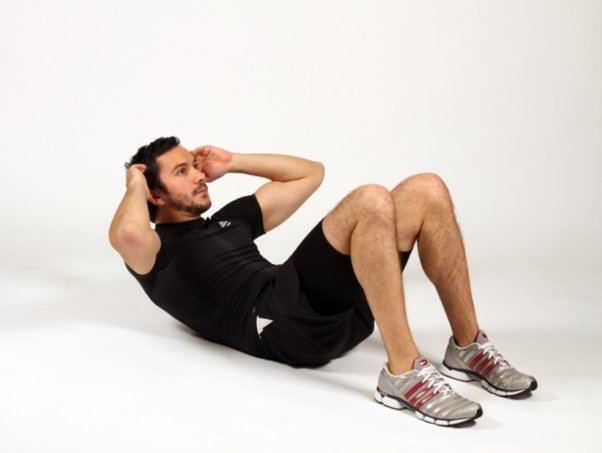In an ongoing battle against obesity, with four in ten Americans grappling with this issue, as per a 2022 Trust for America’s Health report, keeping weight in check has gained significant popularity. With a growing interest in natural ways to lose weight, many individuals seek effective fitness strategies.
Among these strategies, crunches have emerged as a popular choice. However, determining the ideal number of crunches for weight loss remains a mystery to many, leading to confusion and uncertainty. This article will explore the question: “How many crunches a day to lose weight?” and provide insights to help you on your weight loss journey.
What do you mean by Crunches?

Crunches are a common exercise performed to target and strengthen the abdominal muscles. The movement primarily focuses on the rectus abdominis, which is commonly known as the “six-pack” muscle.
During a crunch, the abdominal muscles contract, causing a flexion of the spine. This repetitive motion creates tension in the targeted muscles, stimulating them to grow stronger over time. The primary purpose of crunches is to develop and tone the abdominal region, enhancing core stability and potentially improving posture.
It’s important to note that while crunches primarily engage the rectus abdominis, they also involve other muscles to varying degrees, such as the obliques and hip flexors. However, the intensity and effectiveness of crunches in engaging these additional muscles may vary from person to person, depending on factors such as technique and individual muscle activation patterns.
By regularly incorporating crunches into your workout routine, you can work towards developing stronger and more defined abdominal muscles. However, it’s essential to remember that crunches alone may not be sufficient for overall weight loss or achieving a flat stomach. A comprehensive approach that combines proper nutrition, cardiovascular exercise, and strength training is crucial for attaining sustainable weight loss and overall fitness goals.
How to Perform Crunches at Home?
Performing crunches correctly at home is crucial to maximize their effectiveness and minimize the risk of injury. Understanding the proper technique, breathing, and modifications for different fitness levels ensures you get the most out of your crunches while maintaining safety.
Proper Form
- Assume a supine position with your knees flexed, feet resting flat on the ground, and spaced apart at the width of your hips.
- You can either position your hands behind your head or cross them on your chest.
- To avoid neck strain or pulling on your head, contract your core muscles.
- Lift your upper body using your abdominal muscles, curling towards your knees.
- Focus on the contraction of your abs and maintain a controlled movement throughout.
Breathing Technique
- Breathe as you lift your upper body off the ground, contracting your abs.
- Inhale as you lower your upper body back down to the starting position.
- Maintaining a steady breathing pattern helps stabilize your core and enhances the effectiveness of the exercise.
Modifications for Different Fitness Levels
- Beginners: If you’re new to crunches or have limited core strength, start with a partial range of motion. Lift your upper body only a few inches off the ground and gradually increase the range as you build strength.
- Intermediate: Perform full-range crunches, lifting your upper body as comfortably as possible while maintaining proper form.
- Advanced: Once you have mastered the basic crunch, you can increase the challenge by adding variations such as bicycle crunches, reverse crunches, or incorporating stability balls or resistance bands.
Remember, it’s important to listen to your body and progress at your own pace. Overexertion or improper form can lead to strain or injury. If you experience any pain or discomfort during crunches, it’s advisable to consult with a fitness professional for guidance.
Step-By-Step Guide to Perform Crunches
Performing crunches correctly involves following a step-by-step process to ensure proper technique and effectiveness. Here is a guide to help you perform crunches at home:
Positioning
- Lie down on a mat or comfortable surface.
- Bend your knees, keeping your feet flat on the floor, hip-width apart.
- You can either place your hands behind your head and lightly support it with your fingertips, or cross your arms over your chest.
Engaging your Core
- Take a deep breath in and exhale slowly to engage your core muscles.
- Contract your abdominal muscles, drawing your belly button towards your spine. Doing so will help stabilize your core throughout the exercise.
Starting Position
- Slowly lift your head, neck, and shoulders off the ground using your abdominal muscles.
- Avoid pulling on your neck or using your hands to lift your head. The emphasis should be on your core doing the work.
Range of Motion
- Lift your upper body until your shoulder blades are slightly off the ground.
- Focus on crunching your ribcage towards your pelvis rather than trying to touch your elbows to your knees.
- Maintain a controlled movement, avoiding any jerking or sudden motions.
Breathing
- Exhale as you crunch up, squeezing your abdominal muscles.
- Inhale as you lower your upper body back down to the starting position.
- Maintain a steady and controlled breathing pattern throughout the exercise.
Repetitions and Sets
- Start with a manageable number of repetitions, such as 10-15 crunches.
- Gradually increase the number of repetitions as your core strength improves.
- Aim for 2-3 sets of crunches, resting briefly between sets.
Rest and Recovery
- Take short breaks between sets to allow your muscles to recover.
- Listen to your body and rest as needed, especially if you experience any pain or discomfort.
Benefits of Crunches for Weight Loss
Crunches can be a valuable addition to your weight loss journey, particularly when combined with other exercises and a healthy lifestyle. Here are the key benefits of incorporating crunches into your fitness routine.
Weight Loss
Crunches alone may not directly lead to significant weight loss, as spot reduction is not possible. However, when incorporated into a comprehensive fitness program, including cardiovascular exercises like CrossFit training, crunches can contribute to overall calorie burning and assist in creating a caloric deficit, which is essential for weight loss.
Toning the Abdominal Area
Crunches specifically target the abdominal muscles, including the rectus abdominis and obliques. Consistently performing crunches can help strengthen and tone these muscles, resulting in a more defined midsection. However, it’s important to remember that visible abs also require reducing overall body fat through a combination of exercise and proper nutrition.
Building Core Strength
Crunches are effective in building core strength. The core encompasses more than just the abdominal muscles; it includes the lower back, hips, and pelvis muscles. A strong core is essential for stability, balance, and overall functional fitness. By engaging multiple muscle groups during crunches, you develop core strength, which can enhance your performance in various activities, including CrossFit training.
Improving Posture

Weak abdominal muscles can contribute to poor posture, leading to back pain and discomfort. Regularly performing crunches helps strengthen the core, including the muscles that support the spine. Strong core muscles provide stability and promote proper alignment, thereby improving posture. By maintaining good posture, you can alleviate strain on your back, reduce the risk of injury, and appear more confident.
Accessible Bodyweight Exercise
Crunches are accessible women’s bodyweight exercises that can be easily incorporated into their fitness routines. They require minimal equipment and can be performed at home or in a gym setting. Women can benefit from including crunches in their workouts as part of a well-rounded fitness program to improve overall strength, ton the abdominal area, and promote weight loss.
Safety Tips to Follow While Doing Crunches
Ensuring safety during crunches is essential to prevent strain or injury. By following these safety tips, you can minimize the risk and maximize the effectiveness of your crunches:
Warm Up

Always begin your workout with a proper warm-up. Preparing your body for exercise involves increasing blood flow to the muscles, improving flexibility, and getting ready for physical activity. Incorporate dynamic stretches and light cardiovascular activities like jogging or jumping jacks to warm up your muscles and joints.
Maintain Proper Form
Focus on maintaining proper form throughout the entire range of motion. Avoid pulling on your neck or using your hands to lift your head. Instead, let your abdominal muscles do the work. Keep your neck relaxed and gaze towards the ceiling or slightly forward to avoid strain.
Avoid Strain and Overexertion
Never force or strain yourself during crunches. Finding a comfortable range of motion to engage your abdominal muscles without causing pain or discomfort is crucial. Overexertion can lead to muscle strain or injury. Gradually increase the intensity and number of repetitions, allowing your body to adapt and progress naturally.
Listen to Your Body
Pay attention to your body’s signals during crunches. If you experience sharp pain, dizziness, or difficulty breathing, stop immediately and consult a healthcare professional. Adjust your technique or modify the exercise if necessary. Everyone’s fitness level and capabilities differ, so it’s important to honor your body’s limitations and progress at your own pace.
Gradual Progression
Start with a manageable number of repetitions and gradually increase as your core strength improves. Avoid the temptation to do too much too soon, leading to strain or injury. Gradual progression allows your muscles to adapt and become stronger over time.
Incorporate Variety
While crunches can be effective, it’s crucial to incorporate various exercises to target different muscle groups and prevent overuse injuries. Include other core exercises such as planks, bicycle crunches, or Russian twists to work your abs from different angles and engage different muscle groups.
Rest and Recovery
Allow your body adequate rest and recovery between workout sessions. This allows your muscles to repair and grow stronger. Aim for at least one to two days of rest per week and listen to your body’s need for rest and recovery.
Incorporating crunches into your comprehensive weight loss plan can effectively strengthen your core, tone your abdominal muscles, and improve posture. However, it’s important to remember that crunches alone may not lead to significant weight loss and should be combined with other exercises and a balanced diet. For personalized guidance and to ensure proper form and technique, consult a fitness professional who can tailor a fitness program to your specific needs and goals. Take the first step towards a healthier lifestyle and a stronger core with informed guidance and a well-rounded approach to fitness.
Frequently Asked Questions
How many crunches should I do daily to lose weight?
There is no specific number. Combining crunches with a balanced diet, cardio, and strength training is key for weight loss. Focus on overall fitness rather than solely on crunches.
Are crunches effective for weight loss?
Crunches alone may not lead to significant weight loss. To lose weight effectively, combine crunches with a balanced diet and a comprehensive exercise routine that includes cardiovascular activities and strength training.
Can doing crunches alone help me achieve a flat stomach?
Doing crunches alone is unlikely to give you a flat stomach. While they strengthen abdominal muscles, reducing overall body fat through exercise, proper nutrition, and a well-rounded fitness routine is crucial for achieving a flat stomach.
Can I do crunches every day, or should I take rest days?
It’s generally recommended to incorporate rest days when doing crunches or any exercise. Muscles need time to recover and grow stronger. Aim for 2-3 days of crunches per week, allowing rest days in between for optimal results and injury prevention.
How long does it take to see results from doing crunches?
The time it takes to see results from crunches varies depending on frequency, intensity, overall fitness level, and body composition. But with consistent effort, you will see improvements in several weeks to a few months.
Are there any potential risks or injuries associated with crunches?
When done with proper form, crunches are generally safe. However, improper technique, overexertion, or pre-existing conditions like lower back or neck issues can lead to strain or injury.
Should I , combine crunches with a healthy diet for optimal weight loss?
Yes, combining crunches with a healthy diet is essential for optimal weight loss. A balanced diet that promotes calorie deficit is necessary to complement the benefits of crunches and achieve desired weight loss goals.



